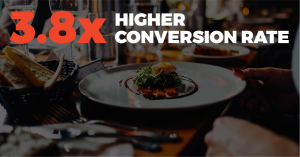How the restaurant chain bucked the trend and increased conversion rate by 35%
Many casual dining restaurant chains have been struggling for the past couple of years.
For instance, Ruby Tuesday saw a drop of 8.2% in revenue and closed 109 restaurants hich hile Applebee’s same-restaurant sales are down by 5.2%. (source)
TGI Friday’s, however, bucked the trend and experienced a 35% increase in conversion rate.
Their secret weapon?
Omnichannel personalization technologies that allow them to create a seamless online and offline experience and interact with customers through various touch points.
By delivering the most relevant and timely content and offers based on a customer’s preferences, habits, and past purchases, TGI Friday’s has increased conversion, ROI, average order value, and customer lifetime value.
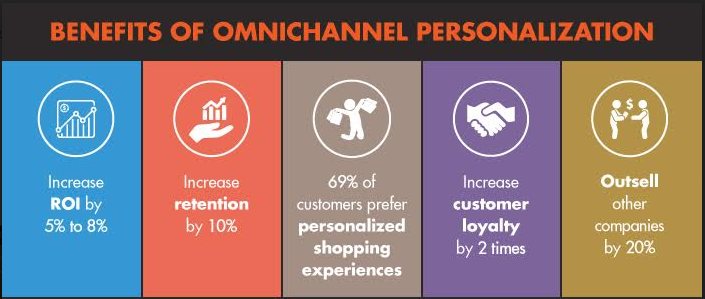
Key takeaways from TGI Friday’s personalization strategy
The challenge for many restaurants when entering the digital realm is bridging the online experience with in-store interactions.
Here’s how TGI Friday’s leverage omnichannel personalization for their marketing:
1. Master Guest Profile (MGP)
TGI Fridays’ integrates all of its owned customer data as well as online digital experience tracking metrics into one centralized platform to create an MGP, which is updated in real-time to reflect the latest customer interactions.
Your MGP should incorporate data such as social media activities, location information, customer preferences, and order history to inform how you can deliver content and offers that will add value and increase sales.
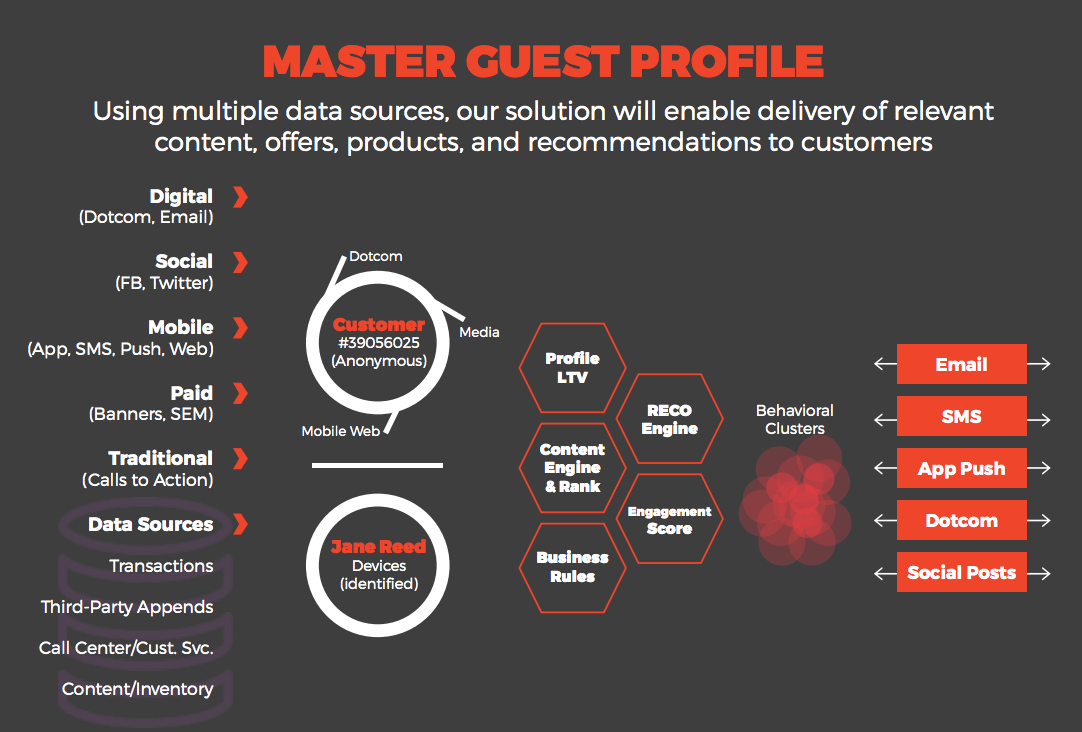
2. Personalized interactions on social media
TGI Friday’s uses a chatbot technology to deliver one-on-one interactions with guests on Twitter, helping them find nearby restaurants, place takeout orders, and more.
Social media platforms are launching more features that allow brands to personalize customer experiences. Besides providing customer service, you can also leverage customer data to deliver personalized offers in the right place at the right time.
3. Special offers via mobile apps
Through their app, TGI Friday’s uses push notification to send reminders based on customers’ past purchasing behaviors. The app also makes it easy for customers to re-order their favorite dishes from a list of past purchases.
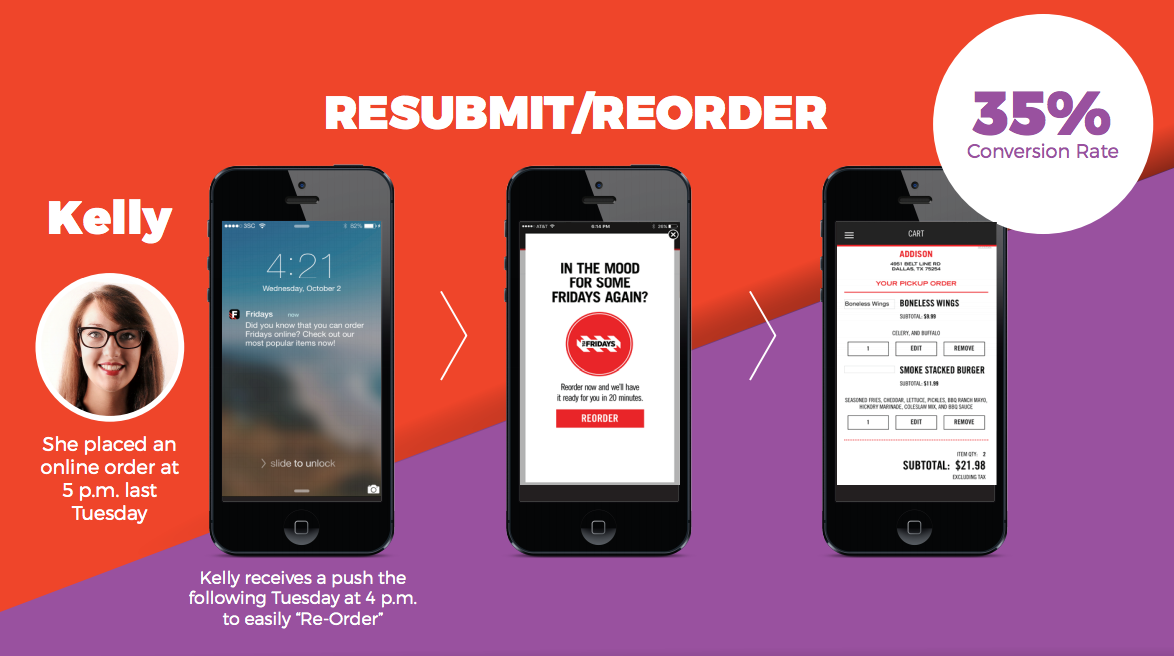
4. Automated email personalization
TGI Friday’s uses email to stay in touch with customers and deliver personalized offers to encourage them to order online or visit the restaurants.
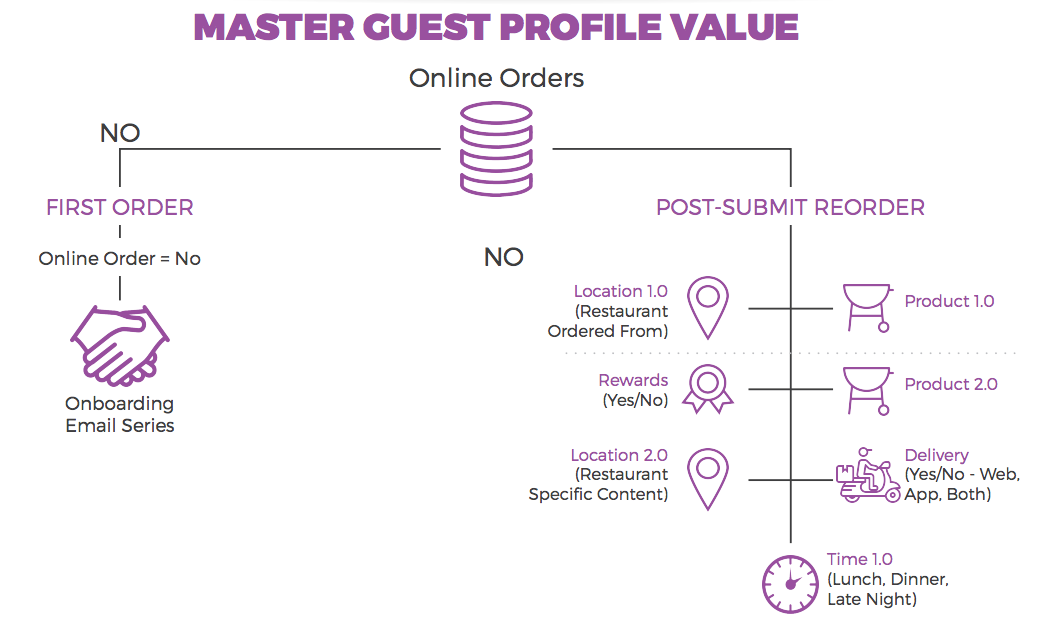
Here are some ideas for using email marketing in your restaurant business by leveraging customer data:
- Offer personalized discounts based on order history.
- Send birthday and anniversary emails.
- Update customers on loyalty rewards.
- Reach out to guests who haven’t visited for a while.
- Offer priority reservation for the busiest holidays.
5. Push notifications to encourage first-time orders
Offering a mobile app is a great way to market your restaurant business. However, having downloaded the app doesn’t imply that a user would convert into a customer.
TGI Friday’s sends out a push notification with a discount code to entice these users to place their first orders. This personalization strategy has helped the restaurant chain 3.8x the conversion rate.
Omnichannel personalization is the new frontier in Restaurant Marketing
New technologies are now making it much easier to collect and analyze a large amount of consumer data to inform your marketing strategies.
By using a robust centralized platform to manage your customer data, you can deliver highly personalized messaging and offers to build relationships with your customers and increase sales.
See how Target, Fig & Olive, and Bank of America are using omnichannel personalization in their marketing
Big brands in every industry vertical are leveraging the power of customer data to deliver personalized campaigns and promotions to increase sales, deepen engagement, and improve customer loyalty.

How are you using customer data to inform your personalized marketing campaigns?
Here are some examples from three industry leaders to get you inspired:
Retail Industry — Target
In 2012, Target made the news by sending a promotional mailer advertising baby gear to a teenage girl before she told her parents about the pregnancy.
The retail giant was able to do so by creating a customer profile on each shopper to store demographic information and track buying behaviors.
Since then, Target has further refined its personalized marketing strategies (besides taking more care to avoid public-relationship disasters) most notably with their app Cartwheel.
The app uses customer data from a centralized database as well as real-time in-store interactions to offer recommendations and discounts based on past purchases and app usage.

Cartwheel features shopping lists with a scanning function, and allows guests to personalize the homepage by choosing exactly which categories to feature.
In addition, the app’s Personalized Recommendations suggest tailored offers based on guests’ in-app activities and Exclusive Offers reward loyal guests with personalized, higher-value offers.
The app boasts over 7 million users while active users have increased their spending at Target by nearly 30 percent.
Restaurant Industry — Fig & Olive
With eight locations across the country, Fig & Olive struggled with the large amount of customer data they have collected both from the point-of-sale systems at their individual locations and from OpenTable.
To leverage this wealth of customer information, the restaurant group developed a centralized reservation center so they can combine data from all locations.
This allows the company to track the dining habits and visit frequency of guests across all of their restaurants.
Using the centralized data platform, the company ran automated personalized email campaigns targeting specific customer behaviors.
For instance, the “we miss you campaign” that offered complimentary crostini to guests who had not visited in the last 30 days resulted in 300 visits and more than $36,000 in sales—an ROI of 700%.
Their automated email campaigns have an extraordinarily high open rate of 53%. Their personalized communication strategy has increased customer loyalty and spending.
In addition, the restaurant group used their customer relationship management (CRM) platform to gather feedback from their guests through online surveys.
By gathering and acting on customer feedback, Fig & Olive decreased negative reviews on Yelp by 36%.
Financial Industry — Bank of America
Bank of America launched BankAmeriDeals, a program that has served 1.5 billion offers to its 30 million online and 14 million mobile banking customers during a 2-year period.
Using data in bank customers’ accounts to discover their purchasing habits, BofA partnered with popular merchants to offer customers deals on products and services.

The program, while keeping the customers’ personally identifiable information within the bank’s database, allows participating merchants to “link” offers of up to 15 percent “cash back” within BofA’s online and mobile banking customers’ accounts.
BofA further increased the relevance of the offers by going beyond national brands. It partners with regional and local merchants to deliver the right level of relevance to the right customers.
This program has helped the bank deepen engagement with their customers, creating a win-win situation for the merchants, customers, and bank.
77% of consumers have chosen, recommended, or paid more for a brand that provides a personalized service or experience.
Personalization is no longer a “luxury” in marketing if you want to cut through the clutter.
It’s time to set up your business to leverage customer data and deliver an outstanding customer experience that increases conversion.
Customer data is driving the next generation of omnichannel marketing strategies. What you can do to stay ahead of your competition.
Every time you interact with your customers, you have the opportunity to aggregate invaluable information. That data can inform your marketing strategies if you leverage it and turn it into actionable insights.
McKinsey predicts that data-activated marketing can boost total sales by 15 to 20 percent (and even more for digital sales) while significantly improving the ROI on marketing budget across all channels.
These strategies are based on a customer’s real-time needs, interests, and behaviors.
We’re not talking about the same old “Hi [ FIRST NAME ]” kind of personalization.
The way companies used to segment their audience is too isolated and simplistic, failing to take into account the complex manner in which consumers interact with brands across all channels, and at various stages of their customer journeys.
With the information available to today’s businesses, it’s not the lack of data that plagues marketers.
Instead, they have access to more data than they know how to utilize effectively.
Thankfully, new technologies are emerging to help brands leverage the vast amount of customer data to deliver personalized messages across all customer touch points, creating an exceptional customer experience.

Here’s how you can activate customer data by implementing personalized marketing campaigns across all channels:
1. Create Single Customer View
A 360-degree customer profile is the foundation of any successful omnichannel personalized marketing campaign.
By using an omnichannel marketing software, you can consolidate all customer data and collect signals from ongoing interactions to aid in the creation of targeted messages and offers.
2. Make Decisions Based On Signals
When customers interact with your brand at different touch points, they leave behind “signals” that can inform your next personalized marketing message.
These “signals” could be cart abandonment, Facebook “check in” at a store, entering an area within your “geo fence,” or returning to your website shortly after a purchase.
3. Deliver Real-Time Personalized Experiences and Offers
By combining signals from a customer’s real-time interaction with your brand and the customer’s history, habits, and preferences, you can deliver the most relevant content or offer in the right place at the right time.
Utilize a centralized platform to implement your personalized marketing campaign so you can deliver consistent messaging across all channels.
This will ensure that all content is working synergistically to move your customers seamlessly along the buyer’s journey.
4. Send Personalized Email
Consumers are fed up with getting one-size-fits-all content and promotions that have nothing to do with their interests, preferences, or habits.
Email is one of the best ways to tailor unique messages. Having them sent at the appropriate frequency positions your brand as relevant and valuable.
It’s an easy way to reach mobile users, a transactional medium perfect for coupons, and allows you to track metrics to understand what works so you can refine your campaigns.
5. Offer Individualized Content On Website
When your customers log onto your website, you can leverage their behavioral data (such as browsing history and interactions with your brand) to deliver relevant and valuable content such as useful articles, localized information, product recommendations or special offers.

Your customer data is a treasure trove of information and it’s the next frontier in personalized marketing.
With the help of today’s technology, you can now tap into that knowledge to help maximize engagement and increase ROI.
Explore our library of resource to see how you can get more leads and generate more sales with omnichannel marketing.
Even though Amazon’s recent acquisition of Whole Foods has brought omnichannel grocery retail to our attention, Walmart has been profiting from the synergy of its well established online and offline grocery retail channels for quite some time.
The company is well positioned to take advantage of the consumer trend in omnichannel retail, in which consumers expect a seamless and consistent user experience across all channels and interactions, including physical stores, web, social media, mobile, call center, and others.
Walmart’s infrastructure allows it to coordinate activities and consolidate data across channels to achieve synergy and efficiency while analytics on its large customer database provide further insights into consumer preferences and behaviors.
Instead of solely focusing on providing delivery service like many eGrocers do, Walmart offers a mix of online and in-store experiences that include drive-through and buy-online-pick-up-in-store to satisfy the various reasons that consumers choose to shop for grocery online.
In Q1 2017, Walmart’s grocery business surged a staggering 63 percent and added 0.8 percentage points to its first-quarter same-store sales gain. Now the company is on track to scaling this offering to more stores.
What’s Walmart doing right in its omnichannel grocery retail strategy? Turns out, quite a bit:
1. Brand Promise of “Everyday Low Price”
A study by Hartman Group found that 35% of consumers order groceries online for better pricing.
Walmart leverages its brand promise of “everyday low price,” which is very appealing to many shoppers. Image source
Image source
Not only does this pricing strategy increase Walmart’s competitiveness in both mainstream and online Grocery markets, but it also helps attract customers used to shopping for food at brick-and-mortar discount or dollar stores.
2. Free Two-Day Shipping
In the same study by Hartman Group, 43% of participants indicated free shipping as a major reason they buy groceries online.
Walmart’s free two-day shipping makes having groceries delivered to their doorsteps a no-brainer for the many customers who want to avoid traveling to a store, dealing with a crowd, and spending time on shopping.
3. In-Store Pick Up Of Online Orders
For customers who like instant gratification but want to avoid the crowd, save time from having to look for items in the store, and enjoy the convenience of utilizing their personalized re-order lists, Walmart offers a service that allows shoppers to place their orders online, choose a time slot, and have the order loaded directly into their cars at their local Walmart.
In addition, the company has recently implemented geo-fencing technology that links up a customer’s mobile device to the local store so the order, which was placed online, will be waiting for the customer at the parking lot.
This omnichannel customer experience is made possible by Walmart’s many physical locations, as well as its robust e-commerce platform and personalization strategy that link their offline operation to the online shopping experience.
4. Employee Delivery
For many online grocery retailers, the “last mile” delivery is often the most costly and creates the biggest logistic challenges.
Walmart is testing a program that pays participating employees to deliver online orders on their way home from work. If successful, this program can potentially increase the efficiency and reduce the cost associated with the “last mile” while delivering an even more seamless online-offline shopping experience to consumers.
The Key To Successful Omnichannel Retail
Successful execution of an omnichannel customer experience is dependent upon a seamless integration of online and offline channels.
Many of these interactions hinge upon the creation of a personalized experience based on each customer’s preferences, behaviors, and interactions with the brand, and it has become imperative that retailers design customer-centric interactions that span online and offline channels.
Amazon’s acquisition of Whole Foods in June 2017 sent a shockwave through the grocery industry. What does it really mean for retailers in the grocery business?
The merger highlights the symbiotic relationship between online and physical stores. Consumers no longer consider them as two distinct experiences but two sides of the same coin that work together to provide a seamless service.
For most grocery retailers doing business at a physical location, the idea of adding an online component can be intimidating.
However, omnichannel retailing has become an essential strategy if you want to stay relevant and competitive in the market.
There’s no question that online shopping is rapidly gaining market share – 51% of Americans prefer to shop online while eCommerce is growing by 23% year-over-year.
Not to mention, consumers are demanding a seamless shopping experience between brick-and-mortar stores and digital channels so they can shop whenever they want, get the best price possible, and have the merchandise delivered to their doorsteps when they want it.
In a recent study of 46,000 shoppers published by Harvard Business Review, 73% of them use multiple channels during their shopping journey. In addition, these customers tend to be more loyal and spend more.
Within the context of the grocery industry, a survey conducted by Unata, 31% of US consumers are likely to shop for groceries online and 80% who have done so will do it again. Meanwhile, 68% who have shopped online are likely to switch to a grocer that provides a better digital experience.

Even though online grocery retail is gaining market share, there are some inherent challenge in the business model. eGrocers often face the challenge of missing out on attracting customers with a tactile, personal experience. They also need to address the “last mile” of distribution while staying profitable.
The convergence of online ordering and offline shopping is emerging as the solution, as Amazon’s acquisition of Whole Foods demonstrates.
This merger has solidified omnichannel retail as the strategy for grocery retailers who want to stay competitive and profitable.
Omnichannel retailing is a tantalizing opportunity for many grocery retailers, reinforced by the technology now available to create a seamless and personal customer experience without breaking the bank.
For instance, the logistics of same-day delivery is now economically feasible while the technology to deliver an omnichannel personalized shopping experience is available to retailers at an affordable cost.
An omnichannel strategy meets your customers’ demand for having the personal experience of shopping in a physical store while enjoying the convenience of managing their orders online and getting groceries delivered to their doorsteps when they need them.
To stay competitive and relevant, grocery retailers need to cater to their omnichannel customers. Here are a few key strategies to keep in mind:
- Offer Multiple Touch points: Omnichannel customers like using a variety of touchpoints in different locations and combinations. Every component – whether it’s a smartphone app, an in-store interactive catalog, or the retailer’s eCommerce website – has to deliver a coherent and seamless customer experience.
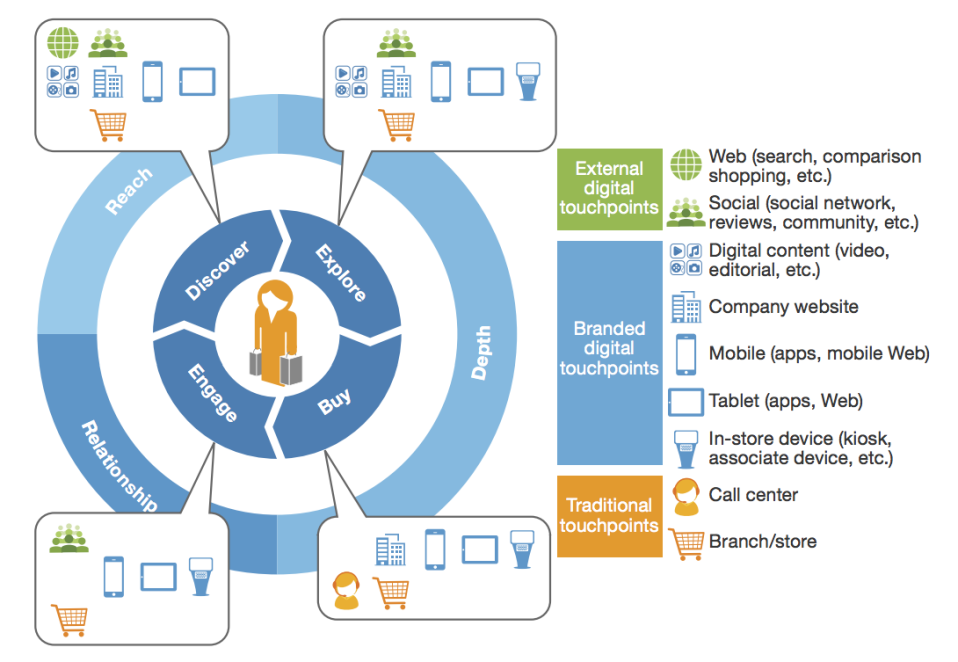
- Encourage Customers to Use More Channels: The Harvard Business Review study revealed that omnichannel customers are more valuable. They spent an average of 4% more in-store and 10% more online when compared to single-channel customers. In addition, customers who use 4 or more channels spent an average of 9% more in-store compared to those who use only one channel.
- Build Loyalty With Personalization: Online channel allows retailers to gain valuable insights into individual shopper’s preferences, habits, and personalities. To make the most out of this goldmine of data, use a Customer Data Management platform. This will allow you to construct 360° customer profiles based on real-time interactions across all channels so you can deliver the most timely and relevant services, information, and product recommendations to your customers to build relationships and increase sales.
As a grocery retailer in this digital era, you’re competing not only with local grocery stores but also national chain retailers.Implementing an omnichannel personalization strategy not only helps you better serve your customers and increase sales but also contributes to better inventory management, improved demand sensing, and streamlined customer support so you can stay competitive and profitable.
When it comes to a brand’s relationship with its audience, it’s all about customer personalization. Customer personalization allows companies to better relate to their customer’s needs and give them a deeper connection to a company. Customer personalization bridges the gap between online experiences and in-person interactions with customers.
Consumers are looking for more ways to connect with a brand, and companies are looking for more ways to increase revenue and track marketing efforts. This makes 2017 the year to focus on personalization. Here are a few customer personalization trends guiding the online experience in 2017:
Enhancing Online Brand Experience
Online shopping is by no means a new concept, but brands are currently working to better connect with consumers online. Common ways to personalize, and therefore enhance, the online brand experience include dynamic content and personalized recommendations. By tracking what consumers look for on a site, companies can personalize the way their site interacts with each customer. This gives everyone a unique experience and encourages them to come back.
One prime example of a personalized online consumer experience is Amazon. Each time a shopper looks at one product, they are then showed similar products, things people have bought, and more. This is all done with the intent of guiding a customer to make a more informed decision.
Optimized Messaging with Customer Data
The average person spends just a few seconds on a page before they decide whether or not to stay. This short attention span makes the content you show them that much more crucial. It’s in those few milliseconds that personalization can make a huge impact.
To do this, companies need to gather the right information about each person who visits their site, so they can better target their efforts to catch that person’s eye. There are multiple methods companies can use to gather data to help with customer personalization. This includes proprietary scoring, targeting algorithms, and more. These processes can help track a person’s every interaction with your brand other similar online brands to provide a personalized experience. Even if someone is a new user to a site, companies with the proper algorithms in place can look at their personal history to improve the content it shows.
Companies such as NectarOM simplify the data collection process to help companies better target messaging and in turn see higher customer engagement that increases overall sales.
Geo-Targeting Marketing
We as a culture are constantly sharing information online, and brands need to take advantage of it. More and more people are becoming comfortable sharing their location online. This allows companies to target content based on a person’s location. Geo-targeted marketing – also referred to as proximity marketing – allows companies to combine online and offline for an improved, cohesive customer experience.
Proximity marketing allows a company to feed the customer their message at a time when they are most likely to take action, based on their location. Proximity marketing uses technology such as chips in products, enabled location services on a smartphone, and in-store WiFi to better reach its customers.
Personalization is imperative for any company that wants to reach its customers online. People aren’t looking for a company that just shows them what they have to offer. Instead, people want to buy from brands that pay attention to them and provide them with custom-tailored content. When it comes to personalization across all channels, companies like NectarOM make simpler to reach customers and increase revenue.
2017
THE RESTAURANT ECOSYSTEM HAS CHANGED AROUND YOU
Customers interact with your brand long after they walk through the door or finish their last bite at your restaurant. Now customers experience your brand in more ways than ever – online, in-app, in-person and at home. The question is how do you capitalize on all those interactions to increase sales?
Easy powerful personalization makes it easy for restaurants to build, operate and scale their omnichannel personalization capability.
Click HERE to learn more
2017
Benefits of Email Marketing
In a world where social media, blogging, and SEO take precedence, email seems like it would be on its way out the door. However, with the business world obsessed with acquiring consumer data, email marketing is not only useful but essential to companies.
Email marketing is one of the most effective and reliable channels for marketers to interact with customers. Here are three reasons why email marketing really works.
1.Easy Way to Reach Mobile Customers
Email marketing is an easy way to reach consumers on mobile without investing in new technology or software. Email channels already exist and are a traditional medium of connection, making it simple to reach consumers. According to a report by Pew Research Center, 52% of cellphone users in the U.S. access their emails via mobile phones. With many consumers constantly on the go, email marketing offers companies a way to send a greater volume of content to consumers in a quick and efficient manner.
Email is also accessible on devices other than mobile phones. According to a study done by Forrester Research, consumers opened 42% of retailers’ emails on smartphones and 17% on tablets. Essentially, nearly 60% of email marketing messages also double as mobile marketing messages. This versatility puts email at an advantage in comparison to text messages and SMS messaging. Consumers are more inclined to open email messages because emails are more accessible. Texting, on the other hand, is only available on mobile devices. Email is also free for the consumer and company while texting risks the chance of an incurred charge on the customer’s end. This diminishes the satisfaction of customer experience and can drive customers away. Also, email marketing is an easier access point for consumers and conveys more content that is useful to consumers.
2. Email is a Transactional Medium
Consumers see emails as a way to get offers, coupons, promotions, and in-stores sales. Email marketing deals drive in-store sales, making product emails key to getting consumers to engage with a product. A study performed by Nielsen found that 27% of online shoppers subscribe to emails in order to save money. 64% of consumers have printed out coupons found on email marketing campaigns.
Since customers expect to see offers and promotions in product emails, they are more likely to be in a buying state of mind. In turn, this can turn into increased revenue opportunity for companies. E-coupons are becoming a huge business with the growth of online sales, and email marketing is at the heart of it. Email marketing reaches out to online bargain hunters and provides consumers with a way to save online and in store. The transactional framework that email marketing provides also allows companies to personalize more toward consumers, engaging them more and further increasing sales opportunities.
3. Tells You What Works
Email marketing allows companies to see what works and what doesn’t. The data obtained from email marketing provides metrics to see how emails are performing and what companies can do to improve email strategies. These insights allow companies to market their products smarter and better. Learning what works because of email marketing also gives companies a better understanding of the needs, interests, and desires of the consumer base. Companies can see the clickthrough rate of an email, which can then provide data as to how shoppers interact with the online shopping platform. Companies use the information provided by email marketing to not only cater to what consumers are looking for, but to better improve the interaction between consumer and company. By using email marketing, companies can track customer activity and better serve their interests.
Some say email marketing is dead. However, email marketing works. It keeps customers engaged and opens channels of communication between the company and its customers. With email marketing, companies can be in the right place at the right time.
Many companies are shifting their focus to engage customers with higher value and profitability. The goal of engaging high-value customers (HVCs) is to nurture them into becoming loyal power shoppers. Increasing loyalty to a brand this way ensures retention and lifetime value of customers.
HVCs drive a significant portion of a company’s revenues. These customers are not only intensely loyal to a brand, but help promote the brand and its influence as well. Engaging and satisfying these high-value customers will put a company on a path toward greater success.
What Is a High-Value Customer?
Confusing high volume and high-value customers can be easy. However, high volume customers and high-value customers are two different target markets.
High volume customers are those who interact with a brand frequently. Although they may engage with the brand often, it doesn’t necessarily mean that these customers are the most valuable. Often with high volume customers, a brand will see a surge in activity for short periods of time. However, once the excitement fades, so does customer engagement.
High-value customers are those who buy for a reason. These customers look at products, services, and brands as a way to meet a need and satisfy a drive such as status, health or lifestyle. HVCs are customers who are loyal to a brand or company, even in times of financial duress. They will return to a brand and product even when a cheaper alternative is available. For HVCs, the cost is not a priority, and are more focused on having their unique needs addressed. HVCs are also brand promoters and influencers. These are the customers who will share the brand within their social networks.
Focusing specifically on high VALUE customers reflects an understanding of the power that these consumers have. Identifying who the high value customers are and tailoring marketing schemes to satiate these consumers, keeps them happy and ensures the brands’ profit margins.
- Evolve With Customers
Customer habits change and evolve. In turn, the way consumers interact with brands has evolved as well. Instead of fighting this evolution, brands should adapt and keep up with their customers. Part of this evolution includes the introduction of new goods and services and outlets, like online shopping. This development means customers are interested in a wide variety of items at all times. A shift towards items outside a consumer’s regular purchase pattern can indicate consumers are turning into HVCs. Dramatic changes in how customers buy items and spend money can also indicate greater trust and loyalty with a brand. Once the customer has extended the olive branch toward a brand, it is very likely they will shift into the high-value customer category.
- Pay Attention
The data provided by a customer’s recent activity can predict if a customer is high value or becoming high value. Data points such as high clickthrough rate, frequent site visits, and large purchases can indicate a customer as a high-value customer. One way to monitor customer involvement and identify high-value customers is through a triggered marketing campaign. Triggered marketing includes a continuous stream of messages sent to customers based on their shopping activity, browsing history, purchases, etc. Triggered marketing indicates to customers that a brand knows its customers.
- Loyalty Rewards
Loyalty programs are teeming with information about members. Everything from brand preferences and item category to price sensitivity can be found in loyalty member data. Harnessing loyalty data helps brands personalize more towards HVCs. Knowing where, when, why, and how customers engage with a brand, can empower companies to create personalized experiences across multiple channels.
Loyalty programs also remove the barrier between customers and their next purchase. These loyalty programs make customers feel like “power users.” Their actions directly correlate to the experience found with a brand and company.
High-value customers make up the untapped bread and butter for many businesses. Understanding the behavior patterns of high-value customers enables brands to engage and target this niche group of customers. Providing high-value customers with the attention they desire keeps them engaged with the brand and propels companies to further success.


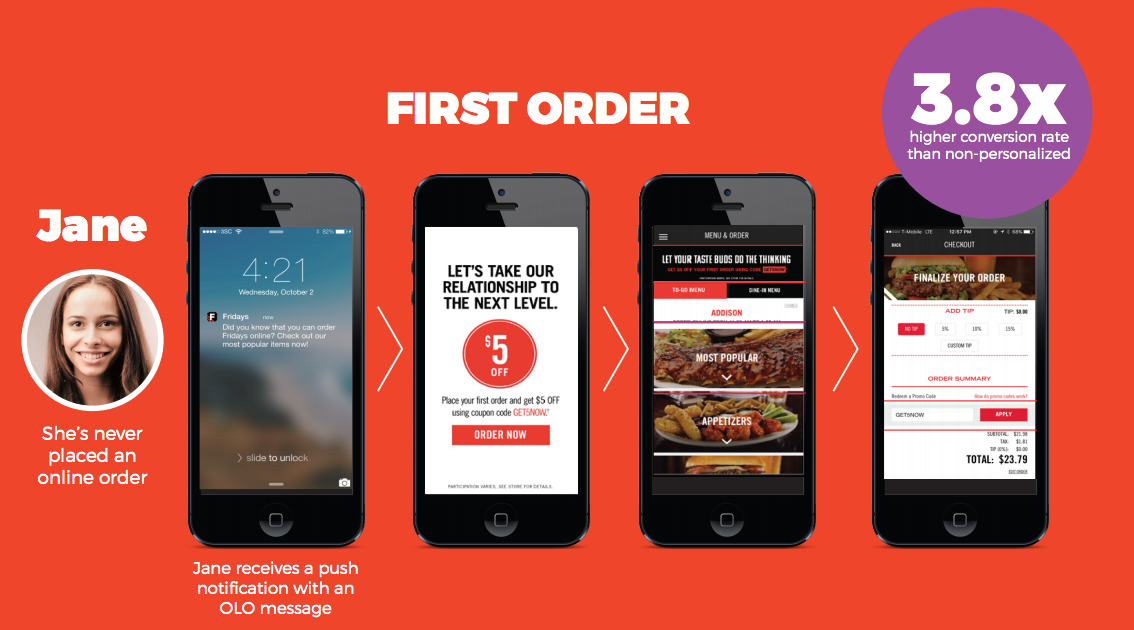
![Big Brands Get Personal With Customer Data [Case Study]](https://nectarom.com/wp-content/uploads/2017/09/DeathtoStock_Wired6-300x200.jpg)


 Image source
Image source

